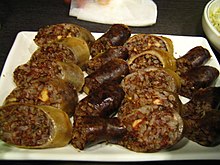Blood (food)
Along with muscle meat and some offal, blood is one of the most nutritious components of animals for slaughter . In addition to a slightly higher proportion of water compared to meat, it contains 18 percent protein and two percent other substances, including iron in particular .
Processing as food
Since blood begins to clot after a very short time in contact with air , it must be beaten if it is not drunk immediately, which delays clotting.
In Europe today it is mainly processed into sausages and the like. Blood sausage is the oldest traditional type of sausage that is already mentioned in Homer's Iliad and is used worldwide in many regional kitchens, for example as a red press head or English and Scottish black pudding , mostly mixed with other parts of the animal and seasoned with herbs . The main ingredients are blood, fat or bacon , often braised onions and milk or cream and regionally different spices.
Traditionally, blood is also a component of blood pudding , blood soup , black and sour or Pomeranian Tollatschen and is also used to bind sauces , especially game dishes such as. B. Hasenpfeffer .
Cultural history
Blood was already used as food by prehistoric hunters and gatherers , presumably in a similar way to societies that still exist today, in which fresh blood and the particularly quickly perishable raw liver serve the hunters as food immediately after the animal has been killed. One of the most original cooking techniques after grilling is cooking in animal stomachs, intestines and skins over an open fire - a preform of the sausage in which , in addition to meat and fat residues, offal and the fermented stomach contents of ruminants, blood could also be used.
A direct form of blood consumption is known from nomadic peoples like the Maasai : the "tapping" of cattle, horses or camels (with the help of a bloodletting bow or bloodletting arrow ), whose blood is then drunk directly or mixed with their milk. Only enough blood is taken that the animals are not seriously harmed. This practice was also common among Berbers and Mongols in the past .
In Judaism and Islam , the consumption of blood is taboo , which is why slaughtering is prescribed there, i.e. killing the animal by severing the carotid arteries, which causes the animal to bleed to a large extent through its own heart activity . What is less well known is that the consumption of blood was prohibited by the church even in the early days of Christianity and was considered pagan. For example, according to the Torah and the Old Testament , God forbids the consumption of blood after the flood ( Genesis 9.4 EU ); it was also forbidden by the apostolic council , of which the New Testament ( Acts 15: 19-21 EU ) reports.
In some cultures, blood was considered the seat of the soul , including animals. In Jewish and Islamic cultures, blood was therefore excluded from consumption. However, in Northern Europe it was considered inappropriate not to use it as it was believed that consuming animal blood conferred power and strength. This idea did not fundamentally change Christianization either; the Nordic peoples kept their traditional blood dishes, such as blood soup or black pudding (see also the Irish Drisheen )
swell
- Alan Davidson : The Oxford Companion to Food. 2nd Edition. Oxford University Press, Oxford u. a. 2006, ISBN 0-19-280681-5 , article: Blood .
Individual evidence
- ^ Richard Kinseher: The bow in culture, music and medicine, as a tool and weapon. BoD - Books on Demand, 2003, ISBN 978-3-831-14109-8 , p. 154 ( limited preview in Google book search).

